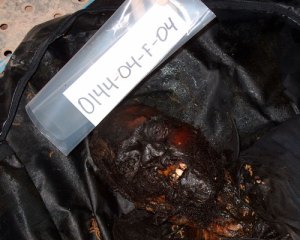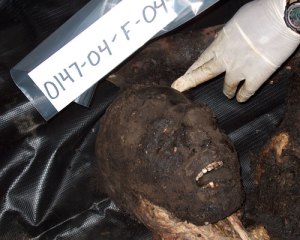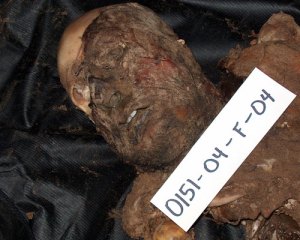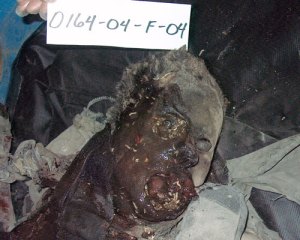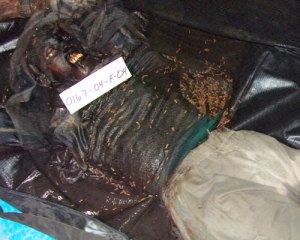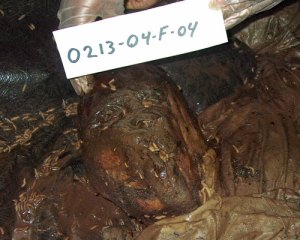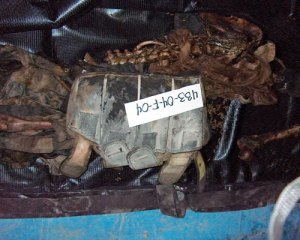Doctors report “unprecedented” rise in deformities, cancers in Iraq
By Larry Johnson
November 16 2009
As we in the news media like to say, violence has “abated” in Iraq. For example, on Monday it was reported that 16 people – including a member of the country’s main Sunni political party and several of his relatives – were killed by gunmen. And a parked car bomb exploded in a market in Kirkuk, killing five people and wounding seven others.
It’s sad to say that the death of 21 people is not too bad, but this is a country that, since the U.S. invasion, often saw a daily civilian death toll topping 100.
But there is another, more insidious violence that is on the rise and will likely continue to rise for generations to come.
The Guardian.co.uk (has and excellent Video) reports that doctors in Fallujah are dealing with up to 15 times as many chronic deformities in infants and a spike in early life cancers that may be linked to toxic materials left over from the fighting.
The report said, “Neurologists and obstetricians in the city interviewed by the Guardian say the rise in birth defects – which include a baby born with two heads, babies with multiple tumours, and others with nervous system problems – are unprecedented and at present unexplainable.”
Actually, this rise in birth defects has been reported on – by, at least a handful of journalists – for years. Iraqi researchers and doctors – for years – have documented the rise of birth defects and cancer primarily in southern Iraq where most of the fighting took place in the first Gulf War. With the second war in Iraq, it seems obvious that the problem is spreading. Depleted uranium has been singled out as the most likely cause.
Depleted uranium, which is used for armor-piercing shells of various sizes, is a highly dense metal that is the byproduct of the process during which fissionable uranium used to manufacture nuclear bombs and reactor fuel is separated from natural uranium. DU remains radioactive for about 4.5 billion years. Many governments have outlawed the use of DU as weapons. The United States has not.
In 2002 and 2003, I researched the effects of depleted uranium in Iraq for stories in the Seattle Post-Intelligencer newspaper.
In the 2002 story:
“Although the Pentagon has sent mixed signals about the effects of depleted uranium, Iraqi doctors believe that it is responsible for a significant increase in cancer and birth defects in the region. Many researchers outside Iraq, and several U.S. veterans organizations, agree; they also suspect depleted uranium of playing a role in Gulf War Syndrome, the still-unexplained malady that has plagued hundreds of thousands of Gulf War veterans…”
At the Saddam Teaching Hospital in Basra, Dr. Jawad Al-Ali, a British-trained oncologist, showed me photo albums he kept of dead and deformed infants that he believed were linked to DU. There were photos of infants born without brains, with their internal organs outside their bodies, without sexual organs, without spines, and the list of deformities went on and on.
In the 2003 story:
“Doctors in Iraq say the number of cancers and birth defects may be devastating.
“‘This is the right time for active support to help prevent the catastrophic effects of the bombing,’ said Dr. Alim Yacoub, dean of the Al Mustansiriya Medical School in Baghdad.
‘“If there isn’t a centralized health plan soon, the consequences could be devastating,’ said Yacoub, the foremost Iraqi authority on the effects of DU. Yacoub has tracked the rise of cancer in Iraq for years, and places the blame squarely on DU.”
An Iraqi scientist, Souad N. Al-Azzawi documented the entire history of DU in Iraq and its devastating effects on the people there, in a presentation to the Kuala Lumpur International Conference to Criminalise War in October. Al-Azzawi, who was forced into exile from Iraq, has devoted many years to her work, at considerable personal risk.
So, the problem isn’t that the rise in cancer and birth defects in Iraq is “unprecedented” or “unexplainable.” The problem is the United States government, and other governments, won’t do anything about it.
They need help the hospitals nor the Doctors can handle all the patients.
The Americans caused the problems and yet will not help them. The children are in desperate need of much more medical help.
Deformed Babies in Fallujah: Iraq Letter to the United Nations
Young women in Fallujah in Iraq are terrified of having children because of the increasing number of babies born grotesquely deformed, with no heads, two heads, a single eye in their foreheads, scaly bodies or missing limbs.
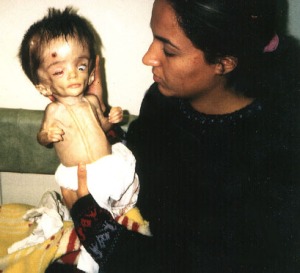 H.E. Dr. Ali Abdussalam Treki
H.E. Dr. Ali Abdussalam TrekiPresident of the Sixty-fourth Session of the United Nations General Assembly
United Nations
New York, NY 10017October 12th 2009Your Excellency,RE DEFORMED BABIES IN FALLUJAH Doctors in Fallujah have specifically pointed out that not only are they witnessing unprecedented numbers of birth defects but premature births have also considerably increased after 2003. But what is more alarming is that doctors in Fallujah have said, “a significant number of babies that do survive begin to develop severe disabilities at a later stage”. As one of a number of doctors, scientists and those with deep concern for Iraq, Dr Chris Burns-Cox, a British hospital physician, wrote a letter to the Rt. Hon. Clare Short, M.P. asking about this situation. She wrote a letter to the Rt. Hon.Douglas Alexander, M.P. the Secretary of State of the Department for International Development (a post she had held before she resigned on a matter of principle in May 2003 ) asking for clarification of the position of deformed children in Fallujah.She received a reply dated 3rd September 2009 (two days after the Sky TV broadcast of 1st September 2009 ) from a junior minister, deputy to The Secretary of State, Mr. Gareth Thomas MP, Duty Minister, Department for International Development. In his reply he denies that there are more than two or three deformed babies in Fallujah in a year and asserts that there is, therefore, no problem. This is at wild variance with reports coming out of Fallujah. One grave digger of a single cemetery is burying four to five babies a day, most of which he says are deformed.Clare Short passed us a copy of this letter. It bears a remarkable similarity to three other written answers we have received over a four year period, in regard to child health and the use of depleted uranium. All these letters are based on lies and an aim to confuse the recipients. In her autobiography “Honorable Deception?” Clare Short says “The first instinct of Number 10 (Downing Street) is to lie.”We regard the mendacity of Mr. Thomas’s letter, and of the other letters we have received, as extremely serious. These letters do not deal with minor matters of corruption, or taxes, but do deal with the use of armed forces and deadly weapons.
The use of certain weapons has tremendous repercussions. Iraq will become a country, if it has not already done so, where it is advisable not to have children. Other countries will watch what has happened in Iraq, and imitate the Coalition Allies’ total disregard of the United Nations Charter, The Geneva, and Hague Conventions, and the Rome Statute of the International Criminal Court. Some countries, such as Afghanistan, will also come to experience the very long term damage to the environment, measured in billions of years, and the devastating effect of depleted uranium and white phosphorous munitions.
If, as we say in our letter to the Duty Minister of the Department for International Development, the UK Government clearly does not know the effects of the weapons it uses, nor, as a matter of policy, does “it do body counts”, how can the UK Government judge whether it is conducting the wars in Iraq and Afghanistan according to International Law, especially in terms of “proportionality” and long term damage to the natural environment? How can the UK know about the illegality of the weapons systems it sells on the international market, such as the “Storm Shadow” missile, if the very Department of the Government that is supposed to assess the deaths and medical needs of children and adults in Iraq is not telling the truth.
We request from the United Nations General Assembly the following:
1. To acknowledge that there is a serious problem regarding the unprecedented number of birth defects and cancer cases in Iraq specifically in Fallujah, Basra, Baghdad and Al – Najaf.
2. To set up an independent committee to conduct a full investigation into the problem of the increased number of birth defects and cancers in Iraq.
3. To implement the cleaning up of toxic materials used by the occupying forces including Depleted Uranium, and White Phosphorus.
4. To prevent children and adults entering contaminated areas to minimize exposure to these hazards.
5. To investigate whether war crimes, or crimes against humanity, have been committed, and thereby uphold the United Nations Charter, The Geneva and Hague Conventions, and The Rome Statute of The International Criminal Court.
Please find enclosed a copy of our letter to Mr Gareth Thomas, dated 12th October 2009, and his letter to The Rt Hon Clare Short, M.P. dated 3rd September 2009, and enclosures relating to this matter.
Yours faithfully,
Dr Nawal Majeed Al-Sammarai ( Iraq Minister of Women’s Affairs 2006 -2009)
Dr. David Halpin FRCS (Orthopaedic and Trauma Surgeon)
Malak Hamdan M. Eng in Chemical and Bioprocess Engineering.
Dr Chris Burns-Cox MD FRCP
Dr. Haithem Alshaibani (Environmental Sciences)
Yasmin Alibhai-Brown (Author and Journalist)
Nicholas Wood MA, RIBA, FRGS
Enclosures to follow by surface mail:
1: Copy of Sky Television Documentary 1 September 2009 “The Deformed Babies of Fallujah”:
2: Copy of Sky Television Documentary June 2008 “The Deformed Babies of Fallujah”.
3: Frieder Wagners’s film “Deadly Desert Dust” 2006.
4: Report by doctors in Fallujah 4 March 2008 ” Prohibited Weapons Crisis”
5: Film the “Dying children of Iraq”,compiled by Nicholas Wood.
6: US Army briefing on the use of White Phosphorous in Fallujah on “Shake and Bake Missions”
7: Report “Who Can Forgive the Crime of using Depleted Uranium Against Iraq and Humanity” by Dr Haithem Alshaibani, September 2009 .
8: Written Answer by Mr Hilary Benn, Secretary of State, Department for International Development to Parliamentary Question. 10 March 2005.
9: Letter by Mr Hilary Benn, Secretary of State, Department for International Development to The Independent, 20 January 2007, in reply to the 98 Doctors’ letter to the Prime Minister.
10: Letter by Rt.Hon. Des Browne, M.P. UK Former Minister of Defence to Rt. Hon. Tony Benn, November 2008
11: Black Country Coroner’s District ( Sandwell, Dudley.and Walsall: ) Coroner’s Report into death of Stuart Raymond Dyson. 18 September 2009.
12: Calculations of expected child abnormalities in a city the size of Cardiff or Fallujah using UK statistics , David Halpin FRCS
Letter from Mr Gareth Thomas M.P. Duty Minister, Department for International Development, 3 September 2009 to Rt. Hon. Clare Short M.P.
Sept 1, 2009
By Lisa Holland
Sadness Of Fallujah’s Sick Children
A doctor in Iraq has told Sky News that more and more children are being born with deformities in Fallujah, a city heavily bombed by the US in 2004. Lisa Holland’s report contains pictures of children with severe medical conditions and deformities. Video Here
This is beyond sad. These poor children and parents should never have had to go through this.
The under taker at a Fallujah cemetery says he buries 4 or 5 newborns every day and most are deformed.
This is compliments of the US invasion.
This is a crime against Humanity and a War Crime to say the very lest.
Words cannot describe, the despair these parents must feel.
This of course happens everywhere the US goes, this is the trail of horror they leave behind. This is caused by the Weapons they used and they sell these weapons to other countries as well.
The soldiers who have been there, can also have children with these types of deformities.
This Video Released in 2007
An award winning documentary film produced for German television by Freider Wagner and Valentin Thurn. The film exposes the use and impact of radioactive weapons during the current war against Iraq. The story is told by citizens of many nations. It opens with comments by two British veterans, Kenny Duncan and Jenny Moore, describing their exposure to radioactive, so-called depleted uranium (DU), weapons and the congenital abnormalities of their children. Dr. Siegwart-Horst Gunther, a former colleague of Albert Schweitzer, and Tedd Weyman of the Uranium Medical Research Center (UMRC) traveled to Iraq, from Germany and Canada respectively, to assess uranium contamination in Iraq
The Hidden Massacre of Fallujah
This is the terrible testimony given by Jeff Englehart, veteran of the war in Iraq. “I have seen women and children burnt bodies – the former U.S. soldier added – phosphorus explodes and it creates a cloud. Whoever is within 150 mt is dead.” Some witnesses have seen a rainfall of burning substances of different colors that were burning people when hit and even those who were not hit had problems breathing”, told us Mohamad Tareq al-Deraji, director of the center for human rights studies in Fallujah.
More pictures of Babies Born in Iraq with Deformities
This is the result of weapons used by the US
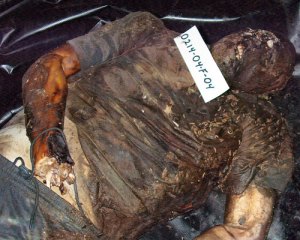
What the US didn’t want anyone to know.
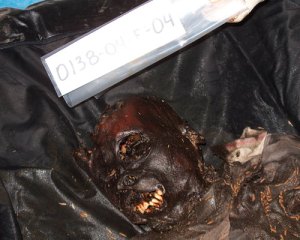
Whether it be Napalm, White Phosphorous or another new Weapon of Mass Destruction the end result it horrifying.
These are the Victims of the US.
This is beyond cruel.
This is beyond a war crime
This is the US inhumanity
Who has and used Weapons of Mass Destruction? Not Iraqis.
How can anyone do this?
This is the true face of war.
Those responsible for this must be held responsible.
Americans must know what their Government did.
Imagine how you would react to this type of horror
How can anyone in the World think this is OK?
How many must die before we Say NO TO WAR?
Is it any wonder they hate Americans?
We also have Children Like this little girl and there are many more like
Mouna.
Mouna’s Story : An Iraqi Girl Struggles to Walk Again
The five-part series chronicles the story of Mouna, a young girl who suffered severe injuries in Iraq, she learned how to walk again, on artificial limbs with the help of MSF/Doctors Without Boarders, surgeons and physiotherapists in Amman, Jordan.
It was a very long, painful road for a little girl to travel.
Part 1
Part 2
Part 3
Part 4
Part 5
Related Articles

